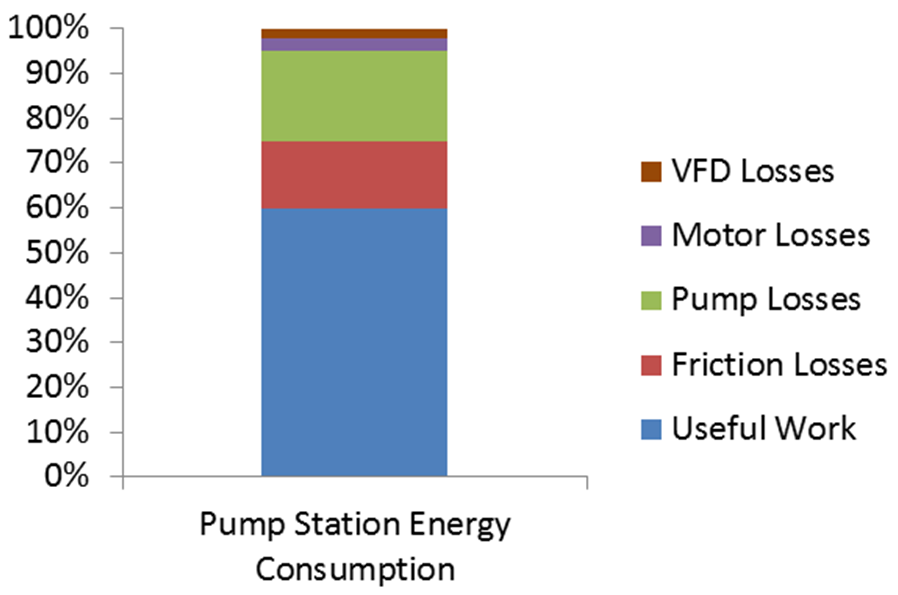Where Does Pump Station Energy Go?
Let's break it down...
To understand how to reduce energy costs, we need to understand where the energy used by a pump station goes. Part of the energy is used to do useful work, typically by raising water from a ground storage tank to an elevated tank. The rest is lost to inefficiencies in the switchgear, motor, pump, friction losses in the pipeline, valves, and other restrictions.
System Efficiency is the ratio of useful work performed by a pump station to the total energy consumed by the pump station. This is what the Dynamic Pump Optimizer (DPO) optimizes.

VFD Losses
VFDs are typically 95% to 97% efficient. However, if you choose to operate your pump station with a DPO, this baseline loss in efficiency is easily overcome by operating near the lowest SEC point. Today, in the water industry, most VFDs are used to smoothly start and stop pumps (smoothly ramping to/from full speed) or for flow or pressure control. In these cases, the potential benefit of continually adjusting the speed to operate the pump station to maximize efficiency is ignored. The Dynamic Pump Optimizer handles this missed opportunity of VFD-controlled pumps by computing optimal pump combinations and speeds to maximize energy efficiency while meeting current demands and smoothly starting and stopping pumps.
Motor Losses
Large induction motors are very efficient at converting electrical energy into rotational energy, particularly when operated at or near full load. NEMA Premium Efficiency Induction motors over 200 horsepower achieve 95% efficiency or better at full rated loads. Smaller motors and submersible motors for well pumps typically have lower efficiencies. Motor efficiency drops slightly as load decreases to 50% of rated load, and then begins to fall off more significantly. Because the DPO uses total power in its computations, motor efficiency is automatically taken into account when computing solutions for a pump station.
Pump Losses
The most efficient large centrifugal water pumps can achieve peak efficiencies in excess of 80%. This rated peak pump efficiency is only achieved when the pump is operating at the specific head condition that exactly matches the BEP (Best Efficiency Point) for that pump. Unlike a motor, it is unlikely that a pump will naturally operate near peak efficiency. With a DPO, pumps with VFDs can be adjusted to operate under all conditions at peak efficiency.
Friction Losses
Water system piping contributes to energy losses through pipe friction losses. The friction loss component for a long-haul piping system can be significant. There are two strategies available to reduce friction losses. The obvious one is to install larger, smoother pipes. A less obvious solution is to schedule the pump station flows to even out the flows over daily demand patterns. Rather than running pumps at full speed for 8 hours a day to meet daily demands, it can often be more effective to run the pumps more slowly over 20 hours or more. Since friction losses are basically a function of flow squared, reducing pump station flow by half reduces piping friction losses by a factor of four! With the Dynamic Pump Optimizer, intelligent pump station scheduling can dramatically reduce energy lost through piping friction losses.
Useful Work
There is a very specific amount of energy required to raise a unit volume of water from a lower elevation to a higher elevation. A pump station that pumps water from one storage tank to another that is 100’ higher will require 314 kilowatt-hours of energy per million gallons, plus energy to overcome VFD, motor, pump inefficiencies, and piping friction losses. To put it another way, raising one million gallons of water by one foot increases the potential energy of that water by 3.14 kWh. The only way to reduce the amount of useful work required by a pump station is to increase the level of the source tank or decrease the level of the target tank.